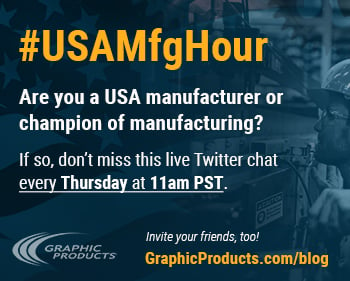Winning at Customer Acquisition and Retention
03
February,
2023
6 MINUTE READ

Converting prospects into customers and having a solid strategy in doing so is an essential component of customer acquisition. It's also a major player in continuous improvement. Businesses must define customer engagement that is worthwhile to achieve business goals. This week's #USAMfgHour on Twitter is by Elizabeth Dodson, co-founder of HomeZada, a digital hub for home and property management. She shares tips on customer acquisition and retention, understanding how and why customer engagement is important, the types of activities companies can perform to have effective customer engagement that leads to customer retention, and how to build a customer engagement strategy.
Creating a Foundation
Most manufacturers and other businesses agree that building rapport and a solid customer relationship develops over time. However, it is engagement and communication that is key to that relationship building. Here's what the #USAMfgHour chat group had to say about what customer engagement means to them and why it's important.
"Customer engagement to us is everything from networking, to making a sale, to following up after the sale and how that customer works with us in each stage," said Rebecca Hart of Dynamatic. She said that while some customers are very engaged, others are not, but the company still tries to keep the engagement at every stage."
"Customer retention is all about meeting your customer's expectations," said Ed Miller, president of Pro Tapes. "The better (you) engage your customers, the better those expectations are defined and made clear."
"Is any engagement good engagement?" asked said Nick Rivers of Obsidian Manufacturing in Illinois.
"The more personalized and valuable the communication, the more likely it will be embraced by the recipient," said Jessica Mancini of Columbus McKinnon, motion control technology. "Generic, untargeted emails are more and more likely to annoy."
"Engaged customers are repeat buyers and your best referral source," said Jennifer Wegman, a marketing professional, and social influencer. "You have to find a good balance between outreach and spammy."
"When customers are engaged, relationships form," said Mike Womack of New Jersey Manufacturing Extension Program. "People do business with people they can trust. By engaging customers, you create trust and retain that business at the same time!"
Getting to the heart of the matter means a lot to customers, which takes "good communication, quick response times, setting expectations, building relationships, and caring about the customer and the results," said Paul Kiesche of Aviate Creative, a marketing agency.
Dodson said that personalized communication and relationship building is great, but it is still important to weigh the return of investment. Customers can provide valuable feedback. "Acquiring customers is important and then making them champions of your products will make all the difference," she said. "For me, it is staying connected to your customers in a way that will benefit them and help you understand more about what is important to them. This will lead to long-term customer retention and customer acquisition."
"Understanding your customers is the foundation to engagement," said Nigel Packer of PelaTis Online, a digital strategy consulting firm. "By improving the customer experience, especially in a digital environment, you make their path to task completion one they enjoy."
"The more engaged the customers, the more likely they will keep on coming back," said Ruby Rusine of Social Success Marketing. She said a way to do that is by creating content that is engaging and focused. She used the retailer Target as an example of how using information from different types of engagement is successful.
"Customers don't like to be forgotten," said JD Allen of Cleveland Deburring. Checking in on them along with any ongoing needs they may have, let's them know they're important to the company and they're business is appreciated. When people are shown appreciation, they tend to be more loyal."
"AND, they're more likely to spread our name by word of mouth," Hart said.
"Having an ongoing relationship with our customers is important to any business," Dodson said. "Having new forms of discussion with customers can also assist us in understanding truly what is important to them."
New Ideas
What types of activities can companies perform for effective customer engagement that leads to customer retention? Chat attendees' answers ranged from traditional and professional tactics to outside-the-box strategies.
"As a wholesaler, we often look for lead forms, any time we have interactions that include link clicks or page/product visits, and of course, any checkout conversions," said Kristina Ingersoll of Ideaman Magnets, manufacturer of 3-D molded rubber magnets.
"You need to collect, gather, and analyze customer feedback to remain in sync with your audience's needs," Mancini said.
"We use good, old-fashioned house calls," said Dan Bigger of Chenango Valley Technologies. "We are not eCommerce. We also use emails, phone calls, and surveys. Every communication provides feedback."
"Depending on the business, regular calls, personal emails, monthly newsletters, or even invitations to company events, like appreciation days or new product unveiling," Allen said. "And if they're close, stopping by with some food now and then is always a nice touch."
"Once, when it had been rainy FOREVER and day, we bought umbrellas, opened them up, and filled them with rubber ducks," said Dondi Scumaci, an author and mentor. "Each duck had our business card tied on. We left those in the lobbies of our best customers. Fun!"
The group said utilizing digital power via social media and platforms such as Zoom, have been pivotal.
"Using a social media calendar and implementing email lists," said Ingersoll. "Right now, we are in the process of testing what works in terms of socials."
"Build a knowledge base rather than a contact list," advised Scumaci. "Find out more about their goals, obstacles, and pain points. Bring insights they will find useful. Ask them how you can help them build their business."
"We also have a lot of different customer personas on our homeowner customers and our partners," Dodson said. "So many industries, different needs, and desires. I decided to go back to lean canvas models to really leverage how to connect with each group."
"Asking questions, listening, and caring is key," said Kiesche. "You can also schedule separate Zooms with clients to go over their goals and understand their needs better. Or keep it casual and fun to build relationships."
"I have been able to meet with people from a much wider geographical area with online networking," said Packer. "Online networking using Twitter and LinkedIn has been progressing. Especially in these types of Q&A sessions. Follow up is through messenger and then moving on to LI when a relationship has developed. Zoom closes the link. Don't try to sell!"
"There are a lot of customer engagement tools. From surveys to focus groups to listening to customers through technical support calls or reseller sales and calls," said Dodson. "Personally, I think we also need to go beyond surveys to really providing valuable tools that engage customers throughout their journeys using our solutions. Partner and distribution sales and calls share with us customer stories that we may be disconnected from. @HomeZada, we have partners in a variety of industries that share more views of how customers use our solutions based on their industry views."
Strategical Moves
 Knowing what customer engagement is, how important it is, and what type of activities, the group was then asked how to build a customer engagement strategy.
Knowing what customer engagement is, how important it is, and what type of activities, the group was then asked how to build a customer engagement strategy.
"We honestly don't have much of a strategy on paper," said Hart. "We're always open to new ideas! We use analytics from Google and our social media platforms and our sales team keeps track of "atta boys" via email. We post them from time to time. If we see little engagement in a method, we might abandon the idea."
"We are still building our sales and marketing departments. It is a work in progress," said Bigger.
"Slowly," said Ingersoll. "By studying past trends, past analytics, and paying attention to what our customers are asking for and building strategies and campaigns around that."
"I don't know that we consider it a strategy as much as a goal," said Sheri of WiscoLift. "We strive to have better communication skills with our customers so that we can better serve their needs and eliminate any problems before they can occur."
"Listen first, do not take what everyone says for face value, so dig deeper into issues, likes, and dislikes customers may have," Dodson said. "Define what you would like to accomplish with your strategy, for instance, to increase retention rates by 2%. Once you define your goals, then you can develop the content or programs to execute, and then it is a must to measure those results of those programs. It is key to identify measurements and analyze these measurements beyond the goal because it will help you see more aspect of what customers are doing and how they are using your solutions."
"We have a fantastic manufacturing facility and we encourage our top customers to visit at least annually," said Miller. "Face to Face meetings are really the best way to review partnerships and re-calibrate expectations."
"Use website data and sales/service feedback to inform what content resonates most with your audience, stay up-to-date with best practices, create a content calendar, and optimize as you monitor engagement," said Mancini.
Dodson's closing thoughts summed up the ideas of how customer engagement leads to customer retention. This in turn leads to loyal fans of a business and then leads those loyal customers to share with others their stories of how a business provided solutions, products, and services.
"Customer engagement leads to happy customers talking to their friends and then those friends become customers," she said.
About #USAMfgHour
Anyone who champions U.S. manufacturing can join in on a new conversation each week on Twitter using the hashtag #USAMfgHour. The chat starts at 11 a.m. Pacific Standard Time/2 p.m. Eastern. Share positive blog posts, helpful articles, news, important information, accomplishments, events, and more with other manufacturers and supporters from throughout the country.
Are you interested in hosting a #USAMfgHour chat? Contact organizers @CVTPlastics, @DCSCinc, and @SocialSMktg.
RELATED RESOURCES

Generating Quality Leads in Manufacturing
Finding the right leads for your business can be time-consuming and, sometimes, lead to nowhere. ...
Read
Maintaining and Expanding Your Customer Base Virtually
Conducting all forms of business virtually has its challenges. For #USAMfgHour on Twitter, Carita Hyman of ...
Read
Simple Brand Management for Manufacturers
Brand management doesn't happen overnight. With a consistent, steady nurturing, manufacturers can effectively ...
Read.png)


